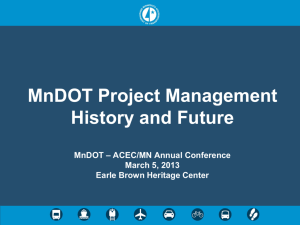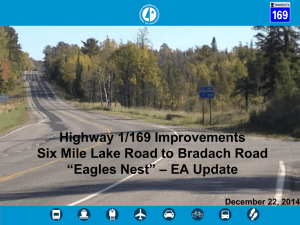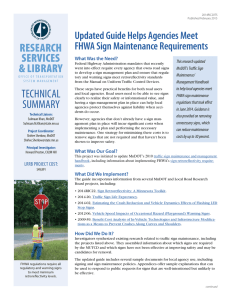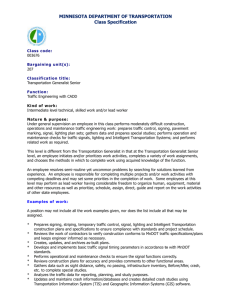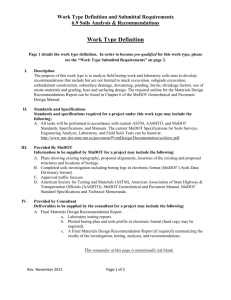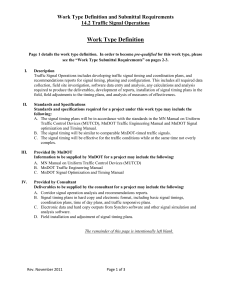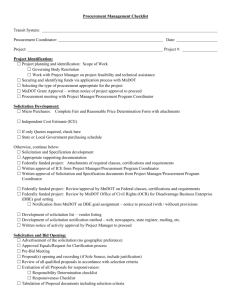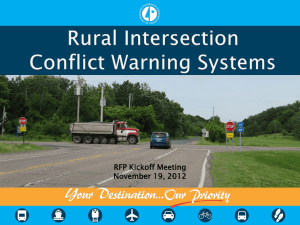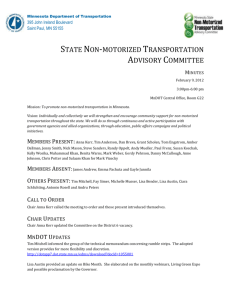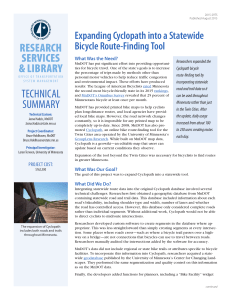RESEARCH SERVICES Working with Industry to Develop an Innovation in Project Contracting
advertisement
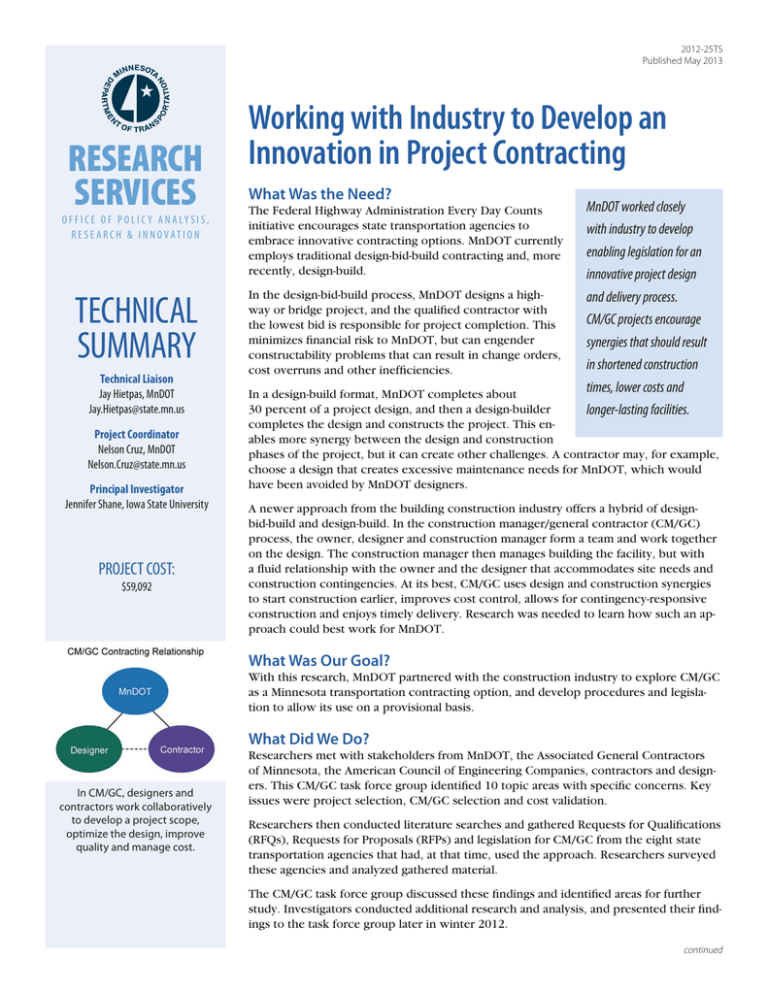
2012-25TS Published May 2013 RESEARCH SERVICES O F F I C E O F P O L I C Y A N A LY S I S , R E SE A R C H & I N N OVAT I O N TECHNICAL SUMMARY Technical Liaison Jay Hietpas, MnDOT Jay.Hietpas@state.mn.us Project Coordinator Nelson Cruz, MnDOT Nelson.Cruz@state.mn.us Principal Investigator Jennifer Shane, Iowa State University PROJECT COST: $59,092 Working with Industry to Develop an Innovation in Project Contracting What Was the Need? The Federal Highway Administration Every Day Counts initiative encourages state transportation agencies to embrace innovative contracting options. MnDOT currently employs traditional design-bid-build contracting and, more recently, design-build. In the design-bid-build process, MnDOT designs a highway or bridge project, and the qualified contractor with the lowest bid is responsible for project completion. This minimizes financial risk to MnDOT, but can engender constructability problems that can result in change orders, cost overruns and other inefficiencies. MnDOT worked closely with industry to develop enabling legislation for an innovative project design and delivery process. CM/GC projects encourage synergies that should result in shortened construction times, lower costs and longer-lasting facilities. In a design-build format, MnDOT completes about 30 percent of a project design, and then a design-builder completes the design and constructs the project. This enables more synergy between the design and construction phases of the project, but it can create other challenges. A contractor may, for example, choose a design that creates excessive maintenance needs for MnDOT, which would have been avoided by MnDOT designers. A newer approach from the building construction industry offers a hybrid of designbid-build and design-build. In the construction manager/general contractor (CM/GC) process, the owner, designer and construction manager form a team and work together on the design. The construction manager then manages building the facility, but with a fluid relationship with the owner and the designer that accommodates site needs and construction contingencies. At its best, CM/GC uses design and construction synergies to start construction earlier, improves cost control, allows for contingency-responsive construction and enjoys timely delivery. Research was needed to learn how such an approach could best work for MnDOT. What Was Our Goal? With this research, MnDOT partnered with the construction industry to explore CM/GC as a Minnesota transportation contracting option, and develop procedures and legislation to allow its use on a provisional basis. What Did We Do? In CM/GC, designers and contractors work collaboratively to develop a project scope, optimize the design, improve quality and manage cost. Researchers met with stakeholders from MnDOT, the Associated General Contractors of Minnesota, the American Council of Engineering Companies, contractors and designers. This CM/GC task force group identified 10 topic areas with specific concerns. Key issues were project selection, CM/GC selection and cost validation. Researchers then conducted literature searches and gathered Requests for Qualifications (RFQs), Requests for Proposals (RFPs) and legislation for CM/GC from the eight state transportation agencies that had, at that time, used the approach. Researchers surveyed these agencies and analyzed gathered material. The CM/GC task force group discussed these findings and identified areas for further study. Investigators conducted additional research and analysis, and presented their findings to the task force group later in winter 2012. continued “With CM/GC, you include construction knowledge early in the process, you get a more realistic schedule and more field-based cost estimates, and you can design to a specific builder.” —Jennifer Shane, Associate Professor, Iowa State University Department of Civil, Construction and Environmental Engineering This project resulted in several white papers addressing various aspects of the CM/GC process, including when to use this process, how to select a CM/GC, the bidding process, how to involve subcontractors, and how to negotiate and validate costs. The group settled on an approach to CM/GC in Minnesota. Researchers summarized findings, prepared white papers on key topics, and proposed procedures and legislation. What Did We Learn? CM/GC appears promising for MnDOT. Industry representatives agreed with the need for innovative approaches to speed transportation project delivery and improve performance. Highlights of the process that was developed include: “Industry representatives saw the need for innovative projects and they were interested in innovation. If they hadn’t helped us, this new process wouldn’t have passed.” • Project selection. The task force group was concerned that CM/GC suits only large construction contracts and would therefore exclude local contractors. The group developed a process that includes industry in selecting projects that are eligible for CM/GC. —Jay Hietpas, Stakeholders expect that the CM/GC process will allow MnDOT full control over design, but MnDOT and the CM/GC will share cost-overrun risk. CM/GCs will be selected based on demonstrated records of quality; contract pricing will be negotiated between MnDOT and the CM/GC, and then validated by an ICE. Project construction will be accelerated because of the freedom to initiate construction before finalizing design and the synergies between construction managers and designers. Director, MnDOT Office of Construction and Innovative Contracting • Construction manager selection. Because the process avoids RFPs and bidding, selecting a CM/GC might lack transparency, as could selecting subcontractors. The group developed a selection procedure that included industry representatives. • Cost validation. The group agreed on the use of an independent cost estimator (ICE) in validating contract costs established by the CM/GC. The ICE would be drawn from retired members of the contracting industry in Minnesota. Legislation was submitted to the Minnesota Legislature and passed in June 2012. MnDOT can now use CM/GC as an innovative contracting approach for 10 projects on a pilot basis. What’s Next? Produced by CTC & Associates for: Minnesota Department of Transportation Research Services MS 330, First Floor 395 John Ireland Blvd. St. Paul, MN 55155-1899 (651) 366-3780 www.dot.state.mn.us/research One project has been identified for CM/GC contracting: a $4 million project to replace abutments on an old truss bridge on Highway 99 while preserving the superstructure. Other projects are under review for potential CM/GC use. Further research on CM/GC in Minnesota could include the development of an internal guidebook for MnDOT. Deeper research on cost valuation and ICE participation may also be valuable as well as consideration of how many rounds of price negotiation will be appropriate with projects. This Technical Summary pertains to Report 2012-25, “Construction Manager/General Contractor Issue Identification,” published August 2012. The full report can be accessed at http://www.lrrb.org/PDF/201225.pdf.
